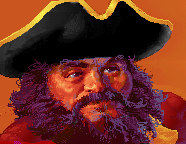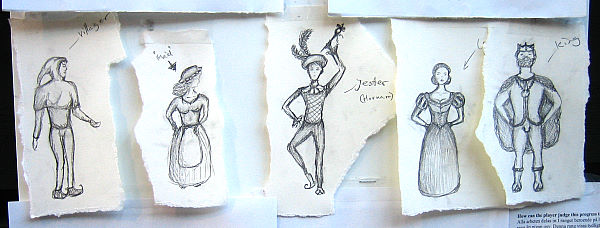An introduction to the basics of designing video game characters. Good character design is critical to financial success in most action and adventure games. This workshop challenges you to design a protagonist character based on a simple description, and decide what sorts of things he or she would do in an action-adventure game. You will also create a
typical level for the hero to have adventures in. | 
| | Stereotypes work well for
simple comedy characters. |
|
In the Character Design workshop the group works in teams of four. The design roles are:-
Lead Designer and Writer (runs the team, writes the game story and character backstory).
- Game Designer (determines core mechanics and powerups).
- Art Director (makes concept sketches, determines visual style of the world and characters).
- Level Designer (creates the detailed level the character will play in).
Issues that you'll work to define: - The character's natural activities, as part of his or her job.
- The challenges that these sorts of actions suggest.
- The character's primary emotional attitude, and how that is displayed visually and in language.
- The character's visual appearance and movement animations, both voluntary and involuntary.
- Attributes and powerups that might affect the character's abilities, and how they grow.
- The character's natural environment, and enemies that may be found there.
This workshop builds on ideas from the Fundamentals workshop. It's ideal for a follow-up visit. How it works.  |
I want to play as... ... Belle Sauvage, glamorous spy
... Erik Thorvaldsson, Viking raider
... Osman Ali Osman, camel driver
... Aristides Mykonos, sponge diver
... Seamus O'Malley, harpoonist
... Red Feather, Apache chief (and there are many more) |
|
Lecture: This workshop begins with a one-hour lecture called "Principles of Character Design."
Setup: I organize the participants into teams, and they choose their roles based on their interests and talents. Once they are settled in, I hand out the
worksheets. Each team gets four worksheets, one for each role, plus a set of general instructions and a printout of the slides from the lecture. Finally, I give them the sealed envelopes containing the character concepts that they will work on. Design—Collaboration Stage: In the first stage, the team works together to define the essential features of the character—what kinds of things such a person does, and what challenges it suggests. As
they reach conclusions, they write them down on their worksheets. Design—Individual Stage: After the collaboration stage, there will still be a good many unanswered questions. At this point each person takes over full authority for his or her own role, and works to fill in the worksheet that goes with it. They are not required to work alone, but they are not obligated to work
together. During this stage the Lead Designer acts as a writer and creates a history for the character. Design—Consolidation Stage: The Lead Designer's worksheet is designed so that it can act as a presentation template. During this stage, the team members consolidate the results of their own work onto the Lead Designer's template. This way the Lead does not have to create a presentation. If there
are more than 10 teams, each team makes a poster during this stage, pasting the concept art and user interface layouts from the worksheets onto a piece of poster board. Presentations: If there are fewer than 10 teams, each presents its work individually. If there are more, each team makes a poster, and the Lead Designer shows it off while the others walk around and look at others' work. During the presentations, I take notes and ask questions. Wrap-up:
I end with a few comments about each character and make some final remarks to the group. 
| Concept art for characters in a game about living in a medieval castle. This is part of a poster presentation. |
|
[ Back to the main Workshop page ]
|